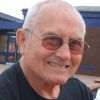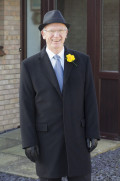Battle of Bosworth
The battle
Battle of Bosworth
A horse, A horse, My kingdom for a horse! Shakespeare would have us believe that King Richard 3rd shouted these words as he was fighting for his life at the Battle of Bosworth on 22nd August 1485. Methinks Shakespeare was using artistic licence to the full.
Richard's army was 10,000 to 15,000 strong and he had taken a position of his own choosing, challenging Henry's forces to attack him. Having chosen the ground, thereby forcing the rebels to attack him close to where his army was camped, it is almost certain that Richard was prepared for battle well before the rebels advanced, giving the lie to the story that Richard was unprepared. The rebel army under Henry Tudor, later to become Henry 7th was a force of 5000 troops, over 2000 of whom were French mercenaries.
For centuries it was understood that the battle was fought on Ambion Hill, Bosworth Field, near to Sutton Cheney village. Recent discoveries however have placed the battle two miles to the south west, where modern exploration methods have unearthed a large collection of canon balls and bullets. The troops in this battle were typical infantry and cavalry of the day, with bows and bills and lances. However, the new weapons using gunpowder, canons and handguns, have provided the key archaeological evidence for the location of the battlefield.
The battle was memorable on three fronts.
-
Richard 3rd was the last English King to be killed in battle.
-
The battle ended 30 years of the wars between the Yorkists and the Lancastrians, which were known as 'The Wars of the Roses.'
-
It is where Henry 7thwas crowned king, thereby beginning the Tudor dynasty.
Henry’s army advanced and when within 1000-600 yards Richard's artillery opened fire. This pinpointed Richard's position and the threat posed by the artillery. So instead of attacking the front, the Earl of Oxford decided to mount a flanking manoeuvre to attack the right wing of Richard’s army, where the Duke of Norfolk commanded. This involved the army turning north-westward, putting the sun at their backs and using the marshes to protect their flank. The success of this manoeuvre suggests that Richard may have made a major tactical error in his deployment, by not protecting his men against such a move.
When the rebel vanguard had passed the marsh they wheeled to the right and this is where they were engaged by Richard's troops. The infantry in the centre of his battle array comprised of archers and billmen, with the archers deployed to the front to deliver the hail of arrows. But as the enemy advanced the archers would have had to withdraw to the protection of the main body of infantry, with the fighting being transformed into a close quarters, hand to hand fight.
King Richard was told that the pretender, Henry was positioned at some distance behind his vanguard, protected by just a small body of men and a guard of horsemen. Richard reviewed the situation and decided that an attack with a relatively small number of heavy cavalry could break through and kill Henry. This was not the act of a defeated warrior. Richard had had considerable military experience. Yes, he had been outmanoeuvred and he could see his vanguard in trouble against the rebel army, but he knew that if he could kill the pretender, then the battle would be won. Importantly he knew that, with luck, a charge by his heavy horse cavalry against a small body of cavalry and infantry, unprotected by archers, could carry the day.
Putting the plan into action, it seemed that Richard’s daring move would succeed, as the heavy cavalry broke through Henry’s guard, getting close enough to the rebel leader to kill his standard bearer. Now Sir William Stanley’s troops, who had been held back on the sidelines, made their decisive counter attack, coming to Henry’s assistance in the nick of time. Richard was cut off from his lifeguard, his horse was driven into the marsh and he was cut down, his head smashed by a rebel poleaxe.
It is uncertain whether the Duke of Norfolk’s vanguard was already near to collapse before Richard’s cavalry charge, or if it was a direct result of Richard's death that they broke and fled.
Finally, with Richard dead, his army dispersed and the rebels in command of the field, Henry addressed his victorious troops on the slopes of an adjacent hill, traditionally Crown Hill in Stoke Golding. Richard had ridden into battle with a crown on his helmet and Lord Stanley took it and placed it on the head of Henry the 7th.

Modern day Evidence
In 2005 the Battlefields Trust was commissioned by Leicestershire County Council, to undertake a major investigation into the exact location of the battlefield.
A team of specialists from differing disciplines was brought in to apply the techniques of battlefield archaeology to search for the battlefield. The original documentary evidence for the battle was studied, the historic landscape was reconstructed, soils were mapped and identified, the peat deposits were analysed to establish the marshes and a systematic archaeological survey using metal detectors was carried out.
The reconstruction of the medieval landscape showed that a marsh had never existed on Ambion Hill. It could only lie in the areas identified as meadow. Soils mapping identified those soils which developed in waterlogged conditions, and these closely matched the areas identified as medieval meadow.
It was discovered that Stoke Golding’s claim to be the birthplace of the Tudor dynasty is likely to be valid, with Crown Hill almost certainly the location where Henry Tudor had been crowned Henry 7th.
All the evidence led to the general area where the action was fought. Systematic archaeological surveys with metal detectors was the method by which the battlefield was located. More than 5000 artifacts have been recorded, though only a small percentage of these relate to the battle.
The project was intensified in 2009 and the core of the battlefield was discovered.
The survey of Bosworth field has so far produced 22 lead roundshot fired from artillery and bullets fired from early hand guns. They range in size up to 93mm, the largest ordnance used in battles in succeeding centuries.
The work at Bosworth battlefield continues.
Today, 4th February 2013, experts from the University of Leicester say that the skeleton that was discovered beneath a car park in Leicester has been confirmed as that of English king Richard III. DNA from the bones match that of descendants of the monarch's family, and carbon dating of the bones date them to 1455 to 1540.
The backbone was malformed with a curvature, backing up the historical facts and Richard's nickname of 'Crookback.'
Richards bones will now be interred in Leicester Cathedral.








